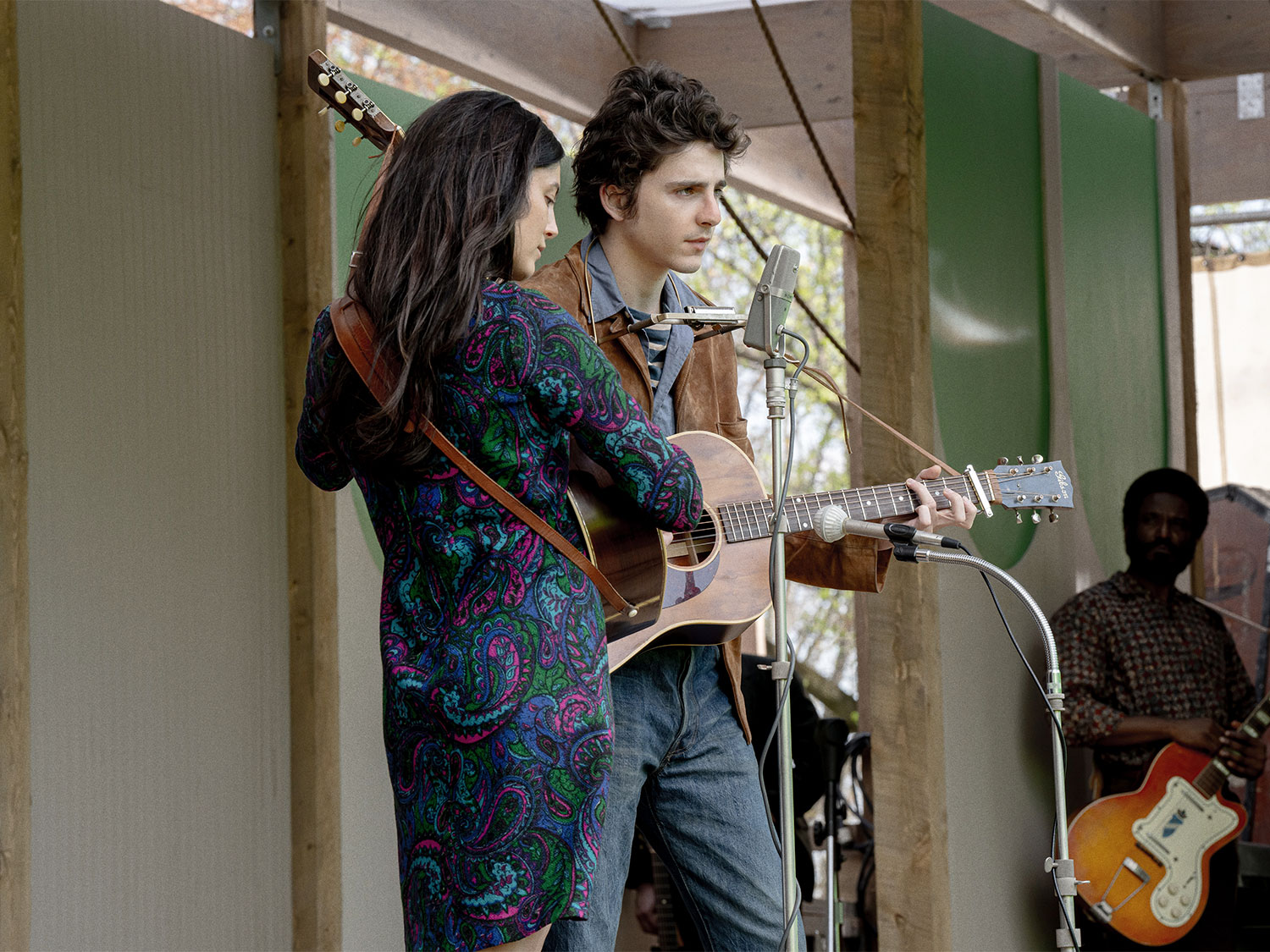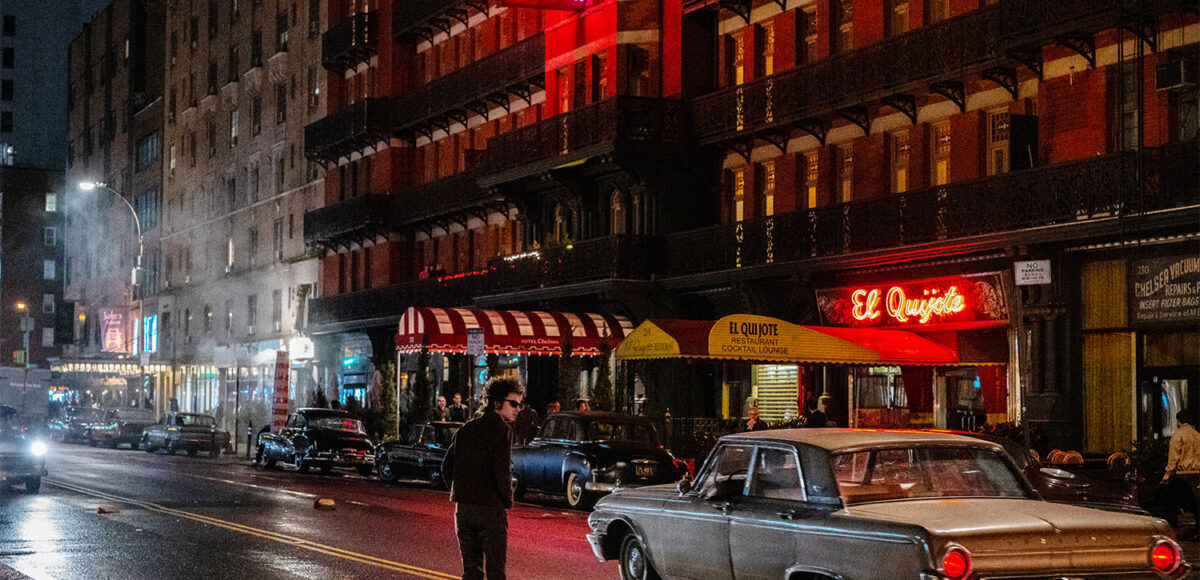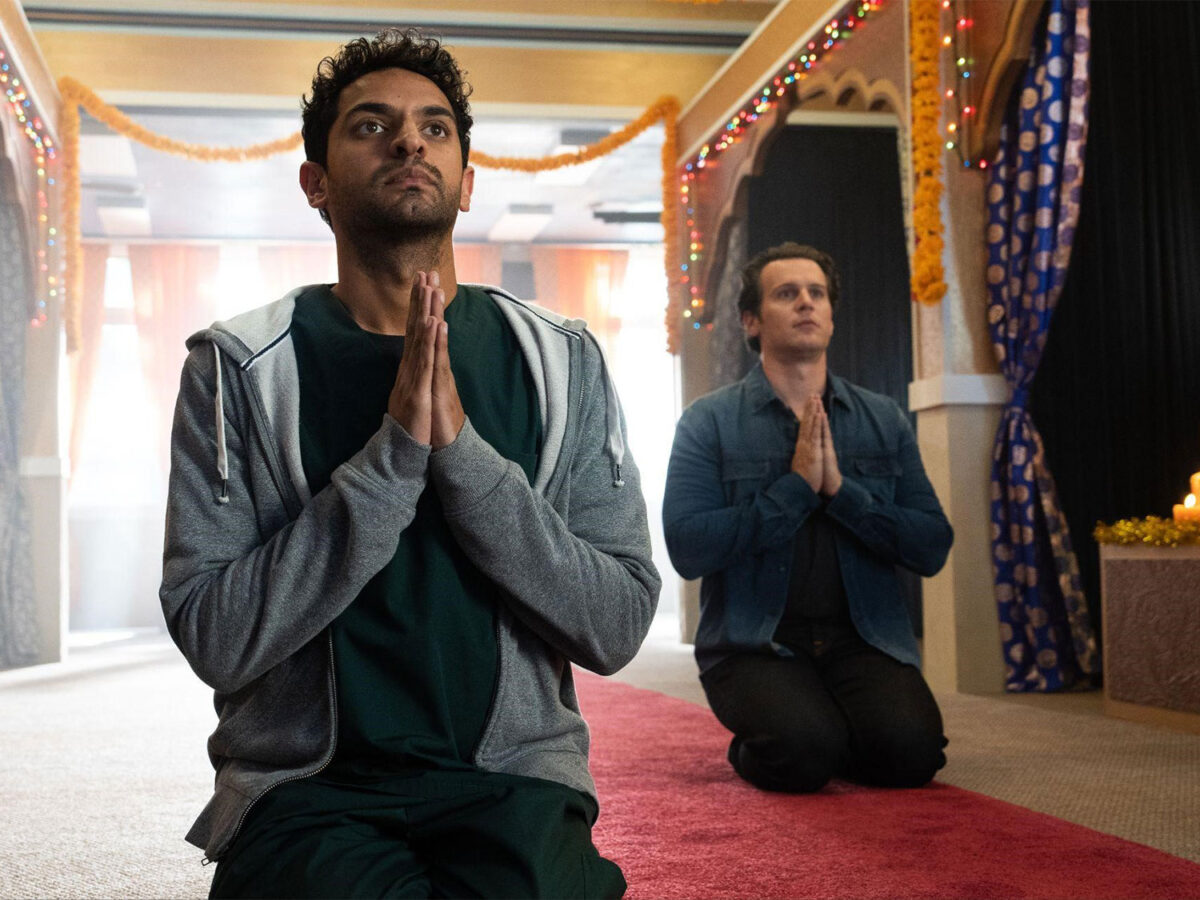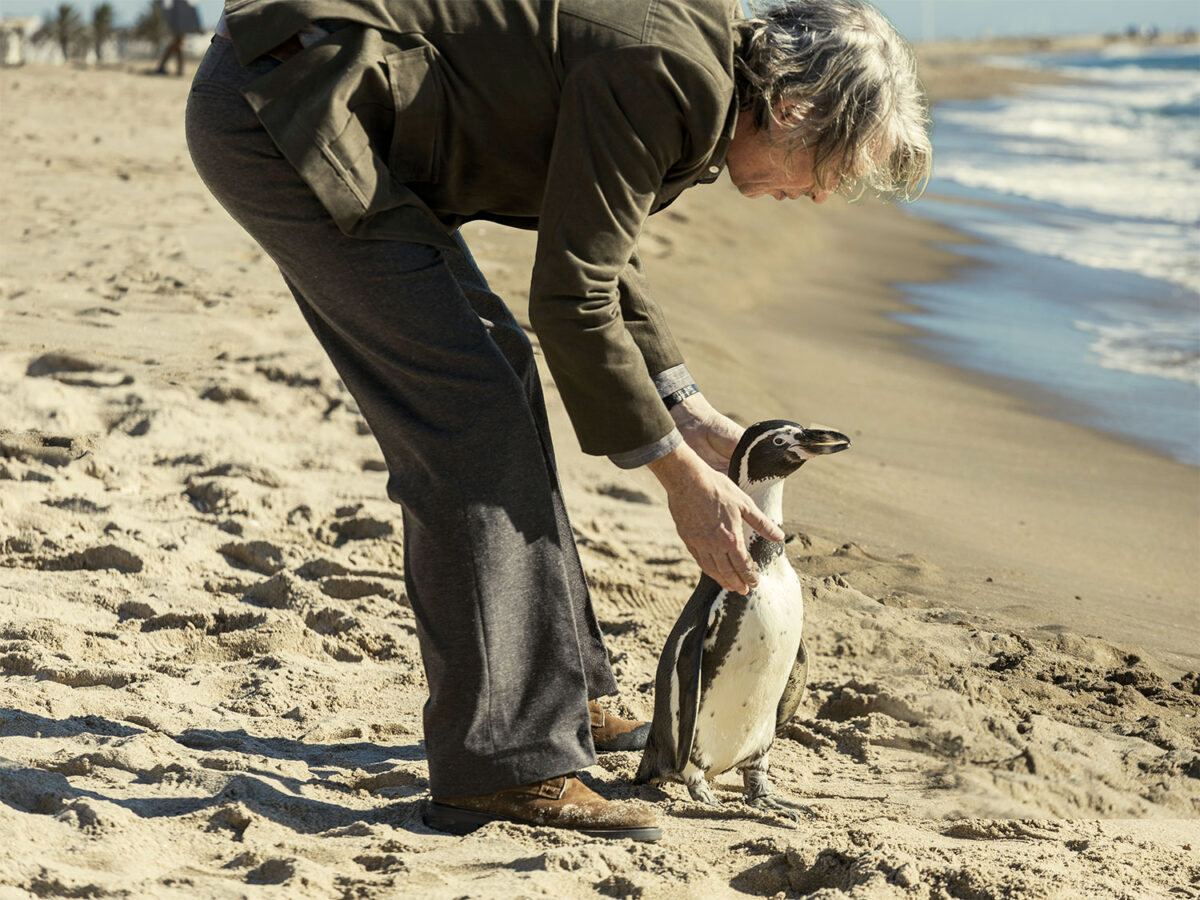He’s just a kid, squashed into the back of some family’s station wagon, guitar propped against a small backpack, staring intently at the lights passing through the wet haze. Dropped off on an empty New York street in the Greenwich Village of decades ago, the village of garbage in the streets, derelicts and dozens of small nightclubs with signs held on by gum and string, he makes his way to a club. Asking a denizen of the bar how to get to the nursing home where Woody Guthrie is hospitalized, he is told it’s in New Jersey. He had just come from there and now must go back, a pilgrimage to the man, musician and icon he reveres the most. So opens James Mangold’s masterpiece, “A Complete Unknown.” Co-written by Mangold and Jay Cocks and directed by Mangold, this is the breathtaking, fully realized, in-depth story of Bob Dylan’s earliest years when he was more loaded with ambition and talent than he was with contacts.
Arriving from Minnesota, a 19-year-old vagabond longing for a platform with a steadfast belief in his overpowering talent, Dylan did make his way back to New Jersey to the hospital where his hero, Guthrie, was incarcerated, not so much by the doctors and nurses but more by the end-stage Huntington’s disease that has him locked into palsies, slurred incomprehensible speech and immobility. It is Guthrie, the troubadour of the Depression and Dust Bowl, composer of “This Land is Your Land,” “John Henry,” “Hobo’s Lullaby” and “House of the Rising Sun,” that he sought out to pay homage to the man who has inspired him to follow in his footsteps. Auspiciously, Pete Seeger, the folk singer who popularized many of Guthrie’s songs and took over the mantle of the people’s balladeer fighting for justice, was there that evening as well. After hearing one of Dylan’s compositions, he’s moved to mentor him in the folk song clubs that dotted the Greenwich Village landscape.
Seeger gave Dylan the credibility that opened doors; Dylan’s outsize talent, immediately evident, brought him onto those stages where he interacted with the stars of the day, foremost among them a soon-to-be-smitten Joan Baez. Although his love affairs and dealings with agents, record company executives and fellow musicians are all presented, this is primarily about Dylan’s astonishing rise and evolution as his generation’s voice, one that continued to morph, over the unbelievably short span from 1961 to 1965. These were the years of “Blowin’ in the Wind,” “A Hard Rain’s A-Gonna Fall,” “Like a Rolling Stone,” “Tambourine Man” and “Times They Are A-Changing,” among too many to mention. In that short period he changed the face of music, not just folk music.
What Mangold has given us is a deep dive into the psyche of a man people thought they knew and understood but didn’t. From the outset, Dylan’s arrogance was not the arrogance of youth but the self-confidence of someone who didn’t need the approval of others. His goal was fame and recognition, but he was totally unprepared for the lack of privacy and the public’s expectations that came with it.
He knew who he was and if others, a group that would include almost his entire circle of friends, gave him their interpretation, that wasn’t his fault. He was who he was. This portrait of Dylan’s genius is also unapologetically narcissistic, manipulative and cruel. He’ll allow nothing or nobody to get in the way of his vision, and there is a body count along the way that includes Pete Seeger, Joan Baez and Sylvie Russo, a stand-in for Suze Rotolo, the girlfriend who left him.

Photos courtesy of Searchlight Pictures
Biopics of the living are notoriously difficult to make. Too often they are either hagiographic or disparaging. Mangold presents what seems to be a clear-eyed vision of a complicated man with singular focus. The actions speak for themselves as does the talent. Even in “No Direction Home” (2005), Martin Scorsese’s outstanding documentary of these same years in Dylan’s career and “Don’t Look Back” by D.A. Pennebaker that follows Dylan’s 1965 tour in the U.K., Dylan, the man, remains an enigma. From the moment he left home, he determined to be knowable only to himself, unknowable to others, a process that allowed him to morph fully into whatever he wanted to be whenever he chose. Most impressively, Mangold avoids those expositional passages that are meant to supply backstory, whether necessary or not. Watch Sylvie as she discovers his personal album marked Robert Zimmerman, her first clue that he hasn’t been entirely forthcoming about his background. It is further proof that he is who he creates himself to be, regardless of past lives.
Mangold has not cracked the enigma code of Dylan, but he has presented a version that operates on a more visceral level. His choice of actor to portray a Dylan who plays at being Dylan was sheer genius, completely out of left field. Timothée Chalamet’s almost translucent features intensify his Dylan’s inscrutable motivation and fluid loyalties or rather lack thereof. Unlike Dylan’s rough-hewn appearance, Chalamet has a delicate physical beauty that is used to underscore his musical talent with a faux vulnerability that projects animal magnetism. The wispy nature of his frame leaves the false impression of weakness, something that Chalamet’s Dylan uses to great advantage, lulling his supporters into viewing him as an ally rather than a competitor. Most surprising is that he has a voice and vocal range that are spot on, an audible doppelganger that knows how to deliver the emotion, anger, loss and love that resides in the lyrics to perfect effect.
Chalamet makes you want to like his character even when he manipulates others to his advantage and their failure. He plays with the likeability of his character like a cat plays with a shiny object. Does his talent, his genius, excuse some of his behavior? You’ll have to answer that question yourself, but for me, and I am nothing if not judgmental, it does. His Dylan does not hide who he is or what his motivations are; it is others who recklessly choose to view him through a different lens. He seemingly betrays so many around him, but it’s all in support of his work. That others project their own values or feelings onto him is not his problem.
Chalamet’s portrayal is the work of a master who completely and believably transformed himself into another. Certainly that is what acting is all about but rarely, very, very rarely, does anyone succeed at the level Chalamet has succeeded in this incredibly difficult role. He’s made us understand the unknowable, if not permanently, at least for a moment.
Edward Norton as Pete Seeger delivers a man so thoroughly tied to his generation that he cannot move beyond it. As his followers diminish in number, he continues on. He truly believes in Dylan’s talent but is perplexed that it leaves no room for him. Norton’s Seeger is both victim and enabler, whose sense of fair play commends and ultimately undoes him. Norton gives three dimensions to a truly good man lost in time. He was caught up in Guthrie’s depression-era mentality that was, to Seeger’s detriment, a stepping stone to the disenfranchisement of the younger generation. Norton’s Seeger didn’t understand the angry young man of the ‘60s. Norton’s marvelous rendition of “This Land is Your Land” was, in effect, the bridge between Guthrie and Dylan.
Other notables in the cast were Monica Barbaro, who was able to play the emotions of Joan Baez, but whose nice voice was not good enough to illustrate how much brighter her star shone for a time. It is, perhaps, unfair to hold her singing to such a high standard, but it is a standard already set by Chalamet’s vocal interpretations. Elle Fanning plays Sylvie with possibly a bit too much co-dependence considering that she should have been seen as independent of her boyfriend’s self-focus. Whether this was in the writing or directing, Fanning’s Sylvie feels slightly less complete. Scoot McNairy as Woody Guthrie has the unenviable task of embodying a horrible disease that locks him into spasms and incomprehensibility. His eyes, however, are his weapon and the non-verbal communication between the young Dylan and the dying Guthrie are some of the most resonant moments in the film.
Using downtown Jersey Avenue, production designer François Audouy transformed this Jersey City street into MacDougal Street of the early ‘60s in exhaustive, realistic detail from the garbage in the streets to the overflowing ashtrays in the bars. His New York becomes a defined character in this film. The hair, makeup and costume design subtly but effectively transformed Chalamet’s delicacy into Dylan without mimicking the man.
“A Complete Unknown” is a must-see triumph. James Mangold has always been a force to reckon with but never more so than now. See it in a theater and be prepared to be swept up by this master work.
Now playing at AMC Theaters throughout L.A. including the AMC Century City15 and the Santa Monica 7.
Neely Swanson spent most of her professional career in the television industry, almost all of it working for David E. Kelley. In her last full-time position as Executive Vice President of Development, she reviewed writer submissions and targeted content for adaptation. As she has often said, she did book reports for a living. For several years she was a freelance writer for “Written By,” the magazine of the WGA West, and was adjunct faculty at USC in the writing division of the School of Cinematic Arts. Neely has been writing film and television reviews for the “Easy Reader” for more than 10 years. Her past reviews can be read on Rotten Tomatoes where she is a tomatometer-approved critic.







